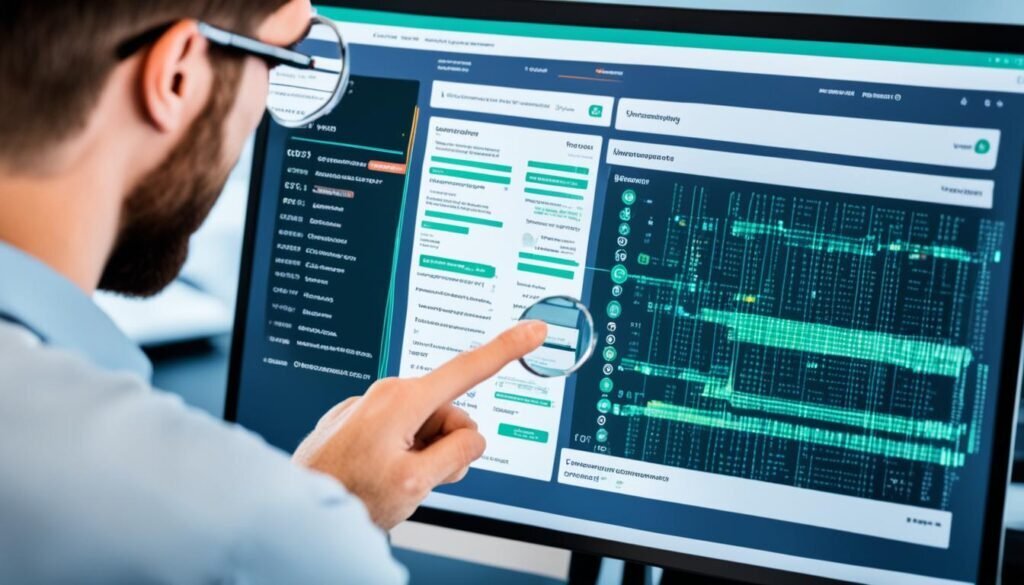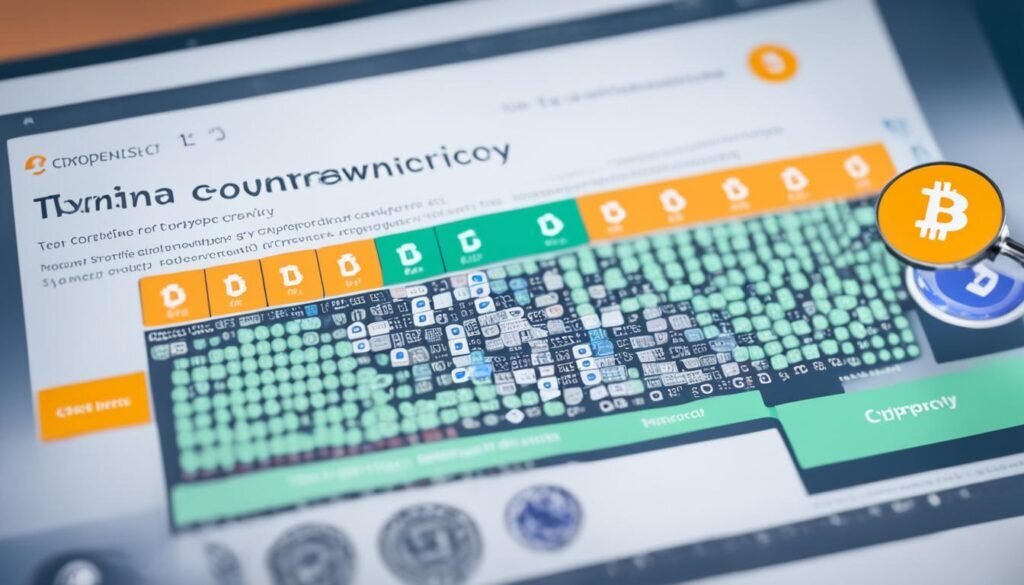Are you confident in the security and validity of your cryptocurrency transactions? Do you know the process of verifying transactions on a cryptocurrency network? The decentralized finance space relies heavily on transaction verification for trust and security. Whether you’re a crypto enthusiast or just getting started, understanding the transaction verification process is crucial.
Join us as we delve into the world of verifying transactions on a cryptocurrency network. In this guide, we will provide a step-by-step process to ensure the trust and security of your transactions in the decentralized finance space. Discover how you can be in control of your transactions and gain confidence in the integrity of the blockchain. As a user, its important to know how is a transaction verified on a cryptocurrency network.
Key Takeaways:
- Verifying transactions ensures trust and security in the decentralized finance space.
- The blockchain serves as a digital ledger for recording all transactions on a cryptocurrency network.
- Following a simple step-by-step process allows you to stay updated on the progress of your transaction in real-time.
- Transaction confirmations and fees play a vital role in the security and progress of your transactions.
- Verifying transactions extends to different cryptocurrencies and non-fungible token (NFT) transactions.
Understanding Transaction Verification on the Blockchain
The blockchain revolutionized the way transactions are recorded and verified in the world of cryptocurrencies. As a decentralized digital ledger, the blockchain ensures transparency, security, and immutability. Understanding the process of transaction verification on the blockchain is essential for individuals seeking to engage confidently with cryptocurrencies.
When a transaction occurs on a cryptocurrency network, it is added to a block. Each block contains a group of transactions and is linked to the previous block, forming a chain of blocks, hence the name blockchain. Every transaction on this chain is verified and confirmed by network participants, known as miners, before it is added to the blockchain.
The process of blockchain transaction verification involves a series of steps to ensure the integrity and validity of each transaction. Once a transaction is initiated, it is broadcasted to the network, where miners compete to solve complex mathematical problems. The miner who successfully solves the problem first adds the block of transactions to the blockchain and validates the transactions within it.
Transaction confirmation on the blockchain occurs when a transaction is included in a block and added to the blockchain. This confirmation signifies that the transaction has been verified by the network and is considered valid. The more confirmations a transaction receives, the more secure and immutable it becomes.
“The blockchain is a groundbreaking technology that provides security and trust by verifying and confirming transactions on a decentralized network.” – Satoshi Nakamoto
To better grasp the concept of transaction verification on the blockchain, let’s take a look at a simple example:
| Transaction | Status | Confirmations |
|---|---|---|
| Transaction A | Confirmed | 5 |
| Transaction B | Confirmed | 3 |
| Transaction C | Pending | 0 |
In the example above, “Transaction A” and “Transaction B” have already received multiple confirmations and are considered valid and secure. However, “Transaction C” is still pending confirmation and hasn’t been added to the blockchain yet.
The transaction verification process on the blockchain ensures the integrity and trustworthiness of transactions. It provides users with the assurance that their transactions are secure, transparent, and irreversible. By understanding the steps involved in transaction verification on the blockchain, individuals can confidently participate in the world of cryptocurrencies.
The Benefits of Transaction Verification on the Blockchain
Transaction verification on the blockchain offers several key benefits:
- Security: By verifying transactions, the blockchain ensures that only legitimate transactions are added to the blockchain, providing a high level of security.
- Transparency: The blockchain’s transparent nature allows users to track and verify transactions in real-time, fostering trust and accountability.
- Immutability: Once a transaction is verified and added to the blockchain, it becomes a permanent and immutable record, preventing any alteration or tampering.
With these benefits in mind, it is clear that transaction verification on the blockchain is critical for maintaining the integrity and trustworthiness of cryptocurrency transactions.
Steps to Verify a Transaction on a Cryptocurrency Network
Verifying a transaction on a cryptocurrency network is a simple process that ensures the integrity and authenticity of your transactions. By following these steps, you can confidently navigate the decentralized finance space.
- Note the Transaction ID: Every transaction on a cryptocurrency network has a unique identification code known as the Transaction ID. This ID serves as a reference point for verifying the transaction. It can typically be found in the transaction history or confirmation email of your wallet or exchange.
- Input the ID into the Blockchain: Once you have the Transaction ID, you need to input it into the blockchain explorer. A blockchain explorer is a tool that allows you to browse the blockchain and access transaction details. By entering the Transaction ID, you can retrieve information about the transaction, including its status and details.
- Check the Transaction Status and Details: After inputting the Transaction ID, you will be able to see the transaction status and details. The status will indicate whether the transaction is confirmed or pending. Additionally, you can view important details such as the sender’s and recipient’s addresses, transaction amount, and timestamp. This information allows you to verify the accuracy of the transaction and ensures that it has been successfully processed.
By following these steps, you can stay updated on the progress of your transaction in real-time. Verifying transaction details and checking transaction status is crucial for maintaining trust and ensuring the security of your cryptocurrency transactions.
Checking Transaction Confirmations and Fees
Once you’ve initiated a transaction on a cryptocurrency network, it’s important to keep track of its progress and security. This section will guide you on how to check transaction confirmations and understand transaction fees, providing you with valuable insights into the validation and security of your transactions.
Transaction Confirmations: Ensuring Security and Validity
Transaction confirmations play a crucial role in guaranteeing the security and validity of your cryptocurrency transactions. When a transaction is made, it needs to be validated by the network’s miners and added to the blockchain. Each confirmation represents the addition of a new block to the blockchain since your transaction was initiated.
The more confirmations a transaction has, the more secure and irreversible it becomes. Each confirmation adds another layer of trust, making it increasingly difficult for malicious actors to tamper with the transaction record. Therefore, it’s important to verify the number of confirmations on your transaction to ensure its completion and integrity.
Keep in mind that the number of required confirmations may vary depending on the specific cryptocurrency and exchange you’re using. Smaller transactions typically require fewer confirmations, while larger ones may necessitate a greater number to ensure maximum security.
Transaction Fees: Supporting Blockchain Security
Transaction fees are a vital component of the cryptocurrency ecosystem, as they support the security and function of the blockchain. When you initiate a transaction, a portion of the transaction value is typically allocated as a fee. This fee serves as an incentive for miners to include your transaction in the next block they validate on the blockchain.
Miners, who are responsible for verifying and validating transactions, prioritize those with higher fees. By offering a competitive fee, you can increase the likelihood of your transaction being confirmed quickly. However, keep in mind that transaction fee rates can fluctuate depending on factors such as network congestion and demand.
Understanding transaction fees allows you to gauge the progress and efficiency of your transactions. It’s important to strike a balance between a reasonable fee and timely confirmation, ensuring that your transaction is processed in a timely manner while supporting the security of the blockchain.
Visualizing Transaction Confirmations and Fees
Here is a visual representation of how transaction confirmations and fees work:
| Confirmations | Transaction Validity | Transaction Fees |
|---|---|---|
| 0 | Not confirmed | Depends on network |
| 1 | Somewhat confirmed | Variable (may be low) |
| 3+ | Highly confirmed | Competitive (higher chance of inclusion) |

The table above illustrates the relationship between transaction confirmations, transaction validity, and transaction fees. As the number of confirmations increases, the transaction becomes more secure and valid. Additionally, higher transaction fees increase the chances of rapid confirmation, benefiting both the miner and the transaction sender.
By understanding transaction confirmations and fees, you can actively monitor the progress and security of your cryptocurrency transactions. This knowledge empowers you to make informed decisions regarding the timing and costs associated with your transactions, ensuring a smooth and secure experience in the world of decentralized finance.
Verifying Transactions of Different Cryptocurrencies
Different cryptocurrencies operate on their own native blockchain or rely on existing blockchain platforms, such as Ethereum for ERC20 tokens. While the specific procedures for verifying transactions may vary, they all share fundamental principles. By researching the specific blockchain and following the earlier mentioned process, you can verify transactions for various cryptocurrencies.
When verifying transactions for different cryptocurrencies, it is essential to understand the native blockchain or platform they utilize. For example, transactions involving ERC20 tokens on the Ethereum blockchain require verification within the Ethereum network.
By conducting thorough research and referring to reliable sources, such as official documentation or community forums, you can gain a better understanding of the transaction verification process specific to each cryptocurrency. Familiarizing yourself with the terminology, tools, and steps involved in transaction verification can help ensure the accuracy and security of your cryptocurrency transactions.
Common Steps for Verifying Transactions
While the exact procedures may differ, here are some common steps to verify transactions of different cryptocurrencies:
- Gather transaction details: Note down the relevant transaction information, such as the transaction ID, sender’s and recipient’s addresses, and the amount transferred.
- Access the blockchain explorer: Utilize a blockchain explorer that supports the specific cryptocurrency’s blockchain. This tool allows you to search for transactions and confirm their validity.
- Enter transaction details: Input the transaction ID or relevant wallet addresses into the blockchain explorer’s search function.
- Review transaction status: Check the transaction status to see if it has been confirmed or is still pending validation by the network.
- Validate transaction details: Verify that the transaction details, such as the sender’s and recipient’s addresses, match the intended transaction.
By following these steps and utilizing the appropriate tools for each cryptocurrency, you can successfully verify transactions and ensure their legitimacy.

Verifying transactions of different cryptocurrencies requires understanding their unique blockchain and following specific verification procedures. By staying informed and utilizing reliable tools, you can securely engage in transactions across various cryptocurrency networks.
Bitcoin Transaction Confirmation Process
Bitcoin transactions undergo a rigorous confirmation process to ensure their authenticity and security. This process involves the participation of miners who validate and add transactions to the blockchain, the decentralized ledger that records all Bitcoin transactions.
Miners play a vital role in upholding the security of the Bitcoin network. Their task involves solving complex mathematical equations to create new blocks of transactions. Once a block is validated, it is added to the existing blockchain, providing an immutable record of all transactions.
The confirmation process begins with the submission of a Bitcoin transaction. This transaction is propagated across the network, and miners start competing to solve the mathematical puzzle associated with the block. The miner who successfully finds the solution first gets the opportunity to add the block to the blockchain.
Once the block is added, the transaction is considered confirmed and becomes a permanent part of the blockchain. Each subsequent block that is added to the blockchain further reinforces the security and validity of the confirmed transaction.
Understanding the Bitcoin transaction confirmation process is important for users to have confidence in the integrity of their transactions. The decentralized nature of the blockchain and the involvement of miners ensure that transactions are securely validated and recorded.
The confirmation process provides a high level of security, as an attacker would need to control the majority of the network’s computing power to modify or invalidate confirmed transactions. The decentralized nature of the Bitcoin network makes this extremely difficult, safeguarding the integrity of the blockchain.
To summarize, here is a table highlighting the key steps involved in the Bitcoin transaction confirmation process:
| Step | Description |
|---|---|
| 1 | User submits a Bitcoin transaction. |
| 2 | Miners compete to solve the mathematical puzzle associated with the block containing the transaction. |
| 3 | The first miner to find the solution adds the block to the blockchain. |
| 4 | The transaction is confirmed and becomes a permanent part of the blockchain. |
| 5 | Additional blocks added to the blockchain further strengthen the security and validity of the confirmed transaction. |
Quote:
“The involvement of miners in the Bitcoin transaction confirmation process ensures the security and integrity of the blockchain, making it a trusted decentralized system.” – Bitcoin Expert
Number of Confirmations Needed for Bitcoin Transactions
When it comes to Bitcoin transactions, the number of confirmations required can vary depending on the exchange and the transaction amount. Confirmations are important for ensuring the legitimacy and security of a transaction. Each confirmation adds an extra layer of assurance that the transaction is valid and irreversible.
For smaller transactions, typically one confirmation is sufficient. This means that once the transaction has been confirmed and added to a block on the blockchain, it is considered valid. However, for larger transactions, it is common for exchanges and merchants to require multiple confirmations.
Multiple confirmations provide a higher level of confidence as they indicate that the transaction has been verified and included in several subsequent blocks on the blockchain. This ensures that the transaction is securely recorded and firmly established in the Bitcoin network.
It’s important to note that each confirmation requires a certain amount of time to process. The time it takes for a transaction to receive confirmations can vary depending on factors such as network congestion and the transaction fee paid. Generally, as the number of confirmations increases, the level of trust and security also increases.
To estimate the processing time for your Bitcoin transactions, you can consider the average block time and the recommended number of confirmations. The Bitcoin network has an average block time of approximately 10 minutes. So, if an exchange or service suggests waiting for six confirmations, you can expect the transaction to be fully confirmed within about an hour.
Keep in mind that the number of confirmations may be different for each exchange or platform. It’s always a good idea to check the specific requirements and recommendations of the exchange or service you’re using to ensure a smooth and secure transaction experience.
Remember, the more confirmations a Bitcoin transaction has, the higher the level of confidence in its validity and security. By understanding confirmation requirements and estimating processing time, you can have peace of mind when conducting Bitcoin transactions.
Tracking Bitcoin Transactions
Tracking your Bitcoin transactions is essential for transparency and ensuring the accuracy of information. By utilizing the provided transaction ID (TxID) or the associated wallet address, you can easily track and verify your Bitcoin transactions using a blockchain explorer like blockchain.info.
Simply enter the TxID or wallet address into the search bar of the blockchain explorer, and it will provide you with detailed information about the transaction, including the sender, recipient, amount, and confirmation status.
Tracking Bitcoin transactions through a blockchain explorer empowers individuals to monitor their transactions in real-time, ensuring the integrity and transparency of the Bitcoin network.
Here is an example of how a Bitcoin transaction can be tracked using the blockchain explorer:
| Transaction ID (TxID) | Sender Wallet Address | Recipient Wallet Address | Transaction Amount (BTC) | Confirmation Status |
|---|---|---|---|---|
| 1a2b3c4d5e6f7g8h9i0j1k2l3m4n5o6p7q8r9s0t | 1BvBMSEYstWetqTFn5Au4m4GFg7xJaNVN2 | 3Kq7X7zfUR79MHMFxBj3aSNZxsYDew4s9z | 0.1 |

Benefits of Tracking Bitcoin Transactions
- Verify the status of your Bitcoin transactions.
- Ensure the accuracy of recipient wallet addresses.
- Track multiple transactions simultaneously.
- Monitor the confirmation progress of your transactions.
- Ensure the security and integrity of the Bitcoin network.
Tracking Bitcoin transactions provides a reliable way to stay informed about the progress and status of your transactions, adding an additional layer of security and transparency to the world of decentralized digital finance.
Verifying Crypto Transactions in Your Wallet
When it comes to verifying transactions in crypto wallets, wallet providers have made the process simple and accessible. By utilizing the account activity section of your wallet, you can easily track and verify your crypto transactions.
Accessing the account activity section allows you to view a comprehensive summary of your transactions, including their confirmations. This feature provides a user-friendly interface where you can monitor the progress of your transactions and ensure their validity.
Whether you are sending or receiving cryptocurrencies, verifying transactions in your wallet brings peace of mind and confidence in the decentralized finance space. By leveraging this functionality, you can stay informed about your wallet account activity and ensure the security of your digital assets.
Stay in control of your crypto transactions by exploring the account activity section of your wallet and verifying each transaction with ease.
With the account activity section, you can track and verify your crypto transactions conveniently within your wallet.
Verifying Crypto Transactions on Other Accounts
If you have information about a specific transaction, such as the wallet address, you can verify transactions on other accounts by using a block explorer that corresponds to the blockchain of the specific cryptocurrency involved in the transaction. Block explorers allow you to browse the blockchain, search for transactions, and verify their completion.
By using a block explorer, you can gain insight into the transaction history and details of other accounts involved in the transaction. This provides transparency and allows you to independently verify the authenticity and validity of the transaction. Here’s how you can verify crypto transactions on other accounts:
- Obtain the wallet address or transaction ID of the specific transaction you want to verify.
- Open a web browser and navigate to a reputable block explorer that supports the blockchain of the cryptocurrency involved.
- Enter the wallet address or transaction ID into the search or transaction lookup function of the block explorer.
- Review the search results to find the transaction you are looking for.
- Check the transaction details, including the sender, recipient, transaction amount, and any associated fees.
- Verify the number of confirmations the transaction has received. The more confirmations, the more secure and irreversible the transaction becomes.
- Ensure that the transaction details align with your expectations and match the information provided by the sender or recipient.
By following these steps, you can independently verify crypto transactions on other accounts, enhancing your trust and confidence in the decentralized nature of cryptocurrencies. Whether you are a buyer, seller, or an interested third party, blockchain verification offers transparency and security in the world of digital finance.
Verifying NFT Transactions

Non-fungible token (NFT) transactions can be easily verified through NFT marketplace activity. NFT marketplaces provide an item activity section where you can track transactions involving specific NFTs. This allows you to verify transactions, even if you are not directly involved, by viewing the accounts associated with the NFTs.
By leveraging NFT marketplace activity, users can gain insights into the transactions related to specific NFTs. This includes details such as the buyer’s and seller’s wallet addresses, transaction timestamps, and transaction amounts. It enables individuals to verify the authenticity and provenance of NFTs, ensuring a trustworthy marketplace for participants.
Tracking NFT marketplace activity is a crucial step in verifying the legitimacy of transactions and avoiding potential scams. By reviewing the transaction history of an NFT and cross-referencing it with the involved accounts, users can ensure the integrity of the transaction and the item being purchased.
Furthermore, NFT marketplace activity also provides transparency in terms of pricing trends and market demand for specific NFTs. By monitoring the transaction activity of similar NFTs, individuals can gain valuable insights into the value and popularity of different NFT collections.
Example NFT Marketplace Activity
| NFT | Transaction ID | Buyer | Seller | Transaction Amount |
|---|---|---|---|---|
| “Artwork A” | 0xabc123xyz | 0xbuyeraddress | 0xselleraddress | 0.5 ETH |
| “Collectible B” | 0xdef456uvw | 0xbuyeraddress | 0xselleraddress | 1 ETH |
| “Digital Asset C” | 0xghi789rst | 0xbuyeraddress | 0xselleraddress | 0.2 ETH |
By analyzing the table above, individuals can gain insights into the recent transactions for specific NFTs. The transaction ID uniquely identifies each transaction, while the buyer and seller addresses provide transparency regarding the parties involved. Additionally, the transaction amounts showcase the value exchanged in each transaction, allowing individuals to better understand the market pricing for different NFTs.
To summarize, NFT marketplace activity plays a vital role in verifying NFT transactions and ensuring the integrity of the marketplace. By tracking and analyzing the item activity section, individuals can validate the authenticity of NFTs, monitor market trends, and make informed decisions regarding NFT purchases.
The Importance of Transaction Verification in Cryptocurrency
Transaction verification plays a vital role in the world of cryptocurrency as it ensures trust and transparency in the decentralized financial ecosystem. By verifying transactions, individuals can confidently participate in the crypto space and rely on the integrity of the blockchain.
Unlike traditional monetary systems where trust is placed in intermediaries such as banks, in cryptocurrency, trust is established through a process of self-verification. Every transaction on the blockchain is recorded and can be transparently viewed by anyone, creating a high level of transparency.
The transparency of blockchain transactions allows users to independently verify the authenticity and validity of each transaction. This empowers individuals to trust in the security and immutability of their transactions, eliminating the need to rely solely on centralized authorities.
Furthermore, the decentralized nature of the blockchain ensures that no single entity has control over the verification process. Instead, the verification is performed collectively by the network of participants, known as miners or validators, who confirm transactions and secure the blockchain through cryptographic algorithms.
The ability to verify transactions in cryptocurrency brings a new level of trust to financial transactions. By being able to independently verify transaction details and their inclusion in the blockchain, users can have confidence that their funds will be securely transferred without the risk of fraud or manipulation.
In summary, transaction verification is essential for establishing trust and transparency in cryptocurrency transactions. It allows individuals to confidently participate in the decentralized finance space, knowing that their transactions are being accurately recorded and secured on the blockchain.
| Benefits of Transaction Verification | Challenges of Transaction Verification |
|---|---|
| Increased trust in transactionsTransparency in financial interactionsElimination of intermediariesReduced risk of fraud | Scalability issuesEnergy consumption for verificationComplexity of cryptographic algorithmsNeed for user education on verification processes |
Conclusion
In conclusion, the process of verifying transactions on a cryptocurrency network is crucial for ensuring trust and security in the decentralized finance space. By following a few simple steps, individuals can confidently engage with cryptocurrencies and rely on the integrity of the blockchain.
The first step in the transaction verification process involves noting the transaction ID, which serves as a unique identifier for the transaction. This ID is then inputted into the blockchain, where it undergoes a verification process by miners. By checking the transaction status and details, individuals can stay updated on the progress of their transactions in real-time.
Transaction verification plays a vital role in establishing transparency and immutability on the blockchain. It allows individuals to have confidence in the validity of their transactions and ensures that the decentralized finance system operates smoothly.
By understanding the importance and steps involved in transaction verification, individuals can navigate the cryptocurrency landscape with ease and make informed decisions regarding their financial transactions.
How is a transaction verified on a cryptocurrency network?
To verify a transaction on a cryptocurrency network, you need to note the transaction ID, input it into the blockchain, and check the transaction status and details.
What is the transaction verification process on a blockchain?
The transaction verification process on a blockchain involves adding the transaction to the blockchain, confirming the transaction through mining, and adding confirmed blocks to the blockchain.
How do I verify transactions on a decentralized network?
To verify transactions on a decentralized network, you can track the transaction using the transaction ID or wallet address on a blockchain explorer or check the account activity section of your wallet.
What are transaction confirmations and why are they important?
Transaction confirmations indicate the number of blocks added to the blockchain since the transaction. They are important as they add further security and validity to the transaction.
What are transaction fees and why are they paid?
Transaction fees are payments made to miners who validate and record transactions on the blockchain. They ensure the security and integrity of the network by incentivizing miners.
How do I verify transactions of different cryptocurrencies?
To verify transactions of different cryptocurrencies, research the specific blockchain and follow the process mentioned earlier using the corresponding blockchain explorer.
What is the Bitcoin transaction confirmation process?
The Bitcoin transaction confirmation process involves miners validating and adding transactions to the blockchain through solving complex equations and adding confirmed blocks.
How many confirmations are needed for Bitcoin transactions?
The number of confirmations needed for Bitcoin transactions varies but typically one confirmation is sufficient for smaller transactions, while larger transactions may require multiple confirmations.
How can I track Bitcoin transactions?
You can track Bitcoin transactions by using the transaction ID or wallet address on a blockchain explorer like blockchain.info to view transaction details and confirmation status.
How can I verify transactions in my crypto wallet?
To verify transactions in your crypto wallet, access the account activity section of your wallet to view a summary of your transactions and their confirmations.
How can I verify crypto transactions on other accounts?
You can verify crypto transactions on other accounts by using a block explorer corresponding to the specific cryptocurrency’s blockchain to browse the blockchain, search for transactions, and verify their completion.
How can I verify NFT transactions?
You can verify NFT transactions by checking the item activity section on NFT marketplaces, where you can track transactions involving specific NFTs and view associated accounts.
Why is transaction verification important in cryptocurrency?
Transaction verification is important in cryptocurrency to ensure trust, transparency, and security, making it possible to confidently participate in decentralized finance and rely on the integrity of the blockchain.








